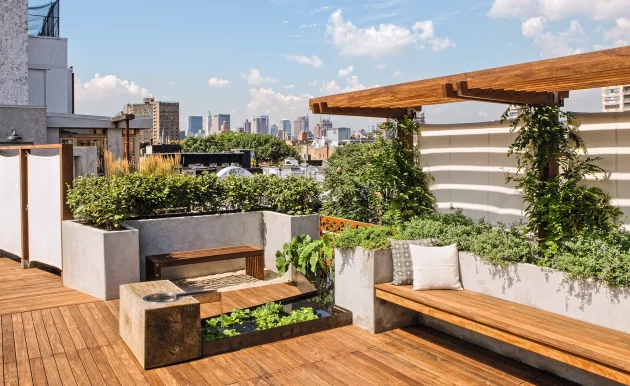Architecture is about more than just building design. It’s also about the design of the grounds around the building. But, what if you don’t have a lot of ground space around your structure? That’s when you can turn to rooftop gardens. Whether you choose to plant an organic vegetable garden from heirloom seeds so people can grow their own food or you just want to plant a flower garden for people to enjoy after a hard day of work, there are plenty of reasons why you might consider including a rooftop garden in your outdoor architecture design.

Connecting With Nature
In cities where ground space is at a premium, a rooftop garden can offer an escape from the hustle and bustle of city life without actually leaving the city. If the garden is atop an office building, workers who can take their lunch or break in a natural setting are more likely to feel more relaxed when returning to work. This can improve productivity and increase job satisfaction levels among employees. In fact, several studies have shown that regular contact with nature not only improves people’s overall sense of wellbeing, but also contributes to a healthier lifestyle.
Improved Air Quality
Rooftop gardens can be instrumental in decreasing air pollution through the processes of photosynthesis and deposition. Additionally, they can also fight greenhouse emissions by reducing the distribution of dust and smog production in urban areas. Of course, one rooftop garden isn’t going to solve the pollution problems in a city all by itself, but if more buildings go green on their roofs, there will be a noticeable positive effect on the air quality in the area. By being the first rooftop garden in a city, your building can start a trend that can help residents breathe a little easier.
Rainwater Retention
Rainwater is a precious resource that is often wasted because buildings have nothing on the roof to collect it. A rooftop garden uses rainwater immediately, thereby making the most out of this gift from nature. Moreover, certain rooftop garden designs can store excess rainwater for future use, a particularly important feature of buildings in hot and dry climates. In the summer months, rooftop gardens can retain as much as 80% of rainwater. Even in the winter, they can still retain up to 40% of precipitation, allowing the water to be used before it evaporates.
Energy Efficiency
Perhaps one of the best benefits of a rooftop garden for urban buildings is that they are more energy efficient. Rooftop gardens provide natural insulation, so the structure will be cooler in the summer and warmer in the winter, reducing demand for air conditioning in the hotter months and heating in the colder months. This will translate into lower energy costs for the building’s tenants or owner, depending on who’s paying the bills.
Conclusion
With lack of space becoming a major problem in many cities, rooftop gardens are a solution to including green space in architecture design. The many benefits of a rooftop garden will enhance the living and working environment for everyone involved with the building.














